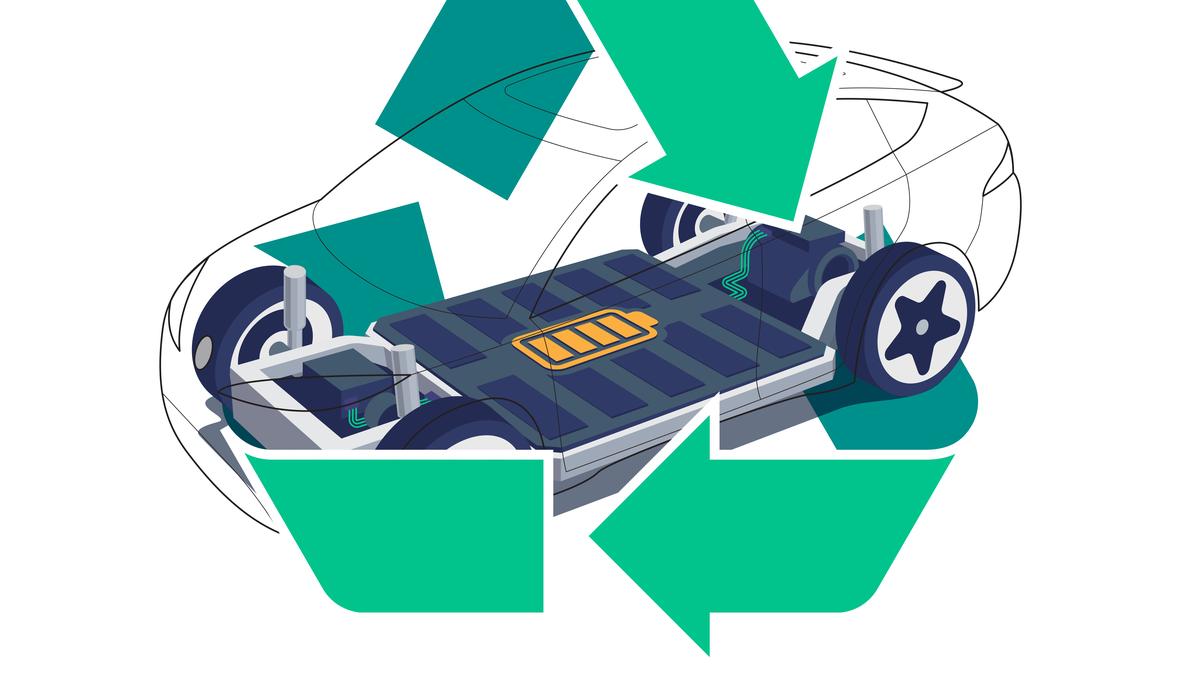
‘Without fair EPR floor pricing, India faces severe environmental degradation from improper battery recycling or dumping’
| Photo Credit: Getty Images
India, with its focus on decarbonisation, has witnessed rapid electrification, particularly in the realm of electric vehicle (EV) adoption. There are projections that India’s EV lithium battery demand may skyrocket to nearly 139 gigawatt-hours (GWh) by 2035 from 4 GWh in 2023. India’s expanding renewable energy sector is also catalysing demand for lithium batteries, with rapid adoption of battery energy storage systems (BESS) to meet India’s Net Zero goal by 2070. While the growth in EV adoption is desirable, it may impose environmental costs without a robust recycling framework in place. Improper disposal of lithium batteries has severe repercussions, including leakage of hazardous materials into soil and water. Added to this is the growing volume of battery waste, with lithium batteries alone accounting for 7,00,000 of the 1.6 million metric tonnes of e-waste generated in 2022. Recognising these risks, the government notified the Battery Waste Management Rules (BWMR) in 2022 to ensure sustainable management and recycling.
The first problem is the floor price
A cornerstone of the rules is the Extended Producer Responsibility (EPR), which compels producers to fund battery collection and recycling, and aims to close the loop in the battery value chain. Producers rely on recyclers to meet their recycling targets since they do not possess the logistics and the infrastructure for the collection of battery waste. In practice, recyclers must receive a minimum price, known as the EPR floor price, in exchange for EPR certificates that attest that producers have met their recycling obligations. The EPR floor price ensures that recyclers are adequately compensated for their upfront investment in infrastructure, research and development, labour, technology and recycling methods.
Unfortunately, there are certain hurdles, the first being the EPR floor price being too low to sustain the robust recycling of battery waste generated by producers. Proper disposal of lithium battery waste is expensive, requiring advanced processing technologies, safe transportation, and skilled labour to prevent hazardous materials from leaching into ecosystems.
Lithium-ion batteries also have valuable and rare minerals such as cobalt, lithium and nickel, whose efficient recovery can significantly reduce India’s import dependence. In case, the EPR floor price does not adequately cover proper recycling costs, it becomes economically unviable for legitimate recyclers to operate sustainably. As a result, informal and fraudulent recyclers tend to flourish, creating market distortions and perverse incentives for producers. They often issue false recycling certificates or dump hazardous waste — a failure previously witnessed in India’s plastic waste management sector. If left unchecked, such practices may undermine India’s circular economy ambitions. Without fair EPR floor pricing, India faces severe environmental degradation from improper battery recycling or dumping. The financial repercussions are equally alarming. Experts estimate that by 2030, inadequate battery recycling could cost India over $1 billion in foreign exchange losses.
A resistance to compliance
Large consumer electronics and manufacturers have further complicated the issue by resisting compliance. Large producers’ policies are different for developed and developing countries, allowing corporations to circumvent environmental responsibilities in developing markets. This trend risks undermining the establishment of resilient and sustainable battery ecosystems across the global south.
Interestingly, adjusting the EPR floor price should not increase costs for consumers. While global metal prices have declined over the past two years, manufacturers have not passed on these savings to consumers, indicating that Original Equipment Manufacturers can absorb higher recycling costs without raising prices. A fair EPR floor price will ensure sustainable recycling without burdening end users, while fostering a circular economy that benefits industry and consumers.
To protect legitimate recyclers and encourage compliance, India must consider adopting a fair and globally comparable EPR floor price that reflects the real costs of recycling and industry building, and which can ease to market-driven prices when the ecosystem is mature and standardisation is in place. This requires immediate constructive dialogue among policymakers, industry and recyclers to establish a viable pricing structure after analysing global pricing structures and best practices. For instance, the United Kingdom requires producers to pay close to ₹600 per kilogram for EV battery recycling, whereas what is under consideration for India is less than a fourth of that. This is a significant difference even after adjusting for purchasing power between India and the U.K. The EPR floor price for recycling battery waste should cover the full spectrum of recycling expenses, from collection to material recovery, ensuring that recyclers can operate sustainably without resorting to shortcuts. A fair EPR regime will also incentivise battery producers to hold recyclers accountable through audits.
Integrate informal recyclers
Enforcement mechanisms need urgent strengthening in India. This includes implementing robust audit systems, digitising the issuance and the tracking of EPR certificates, and imposing stringent penalties for fraud and non-compliance. Additionally, integrating informal recyclers into the formal sector through training and regulatory support can help eliminate hazardous practices while expanding India’s recycling capacity. This is not just an environmental challenge. It is an economic and strategic imperative. By recalibrating the EPR floor price, strengthening enforcement, and formalising the informal sector, we can transform battery waste from a looming crisis into a catalyst for green growth and a truly circular economy.
Arun Goyal is a retired IAS officer. He is a former Secretary to the Government of India and a former Member of the Central Electricity Regulatory Commission
Published – August 05, 2025 12:08 am IST
